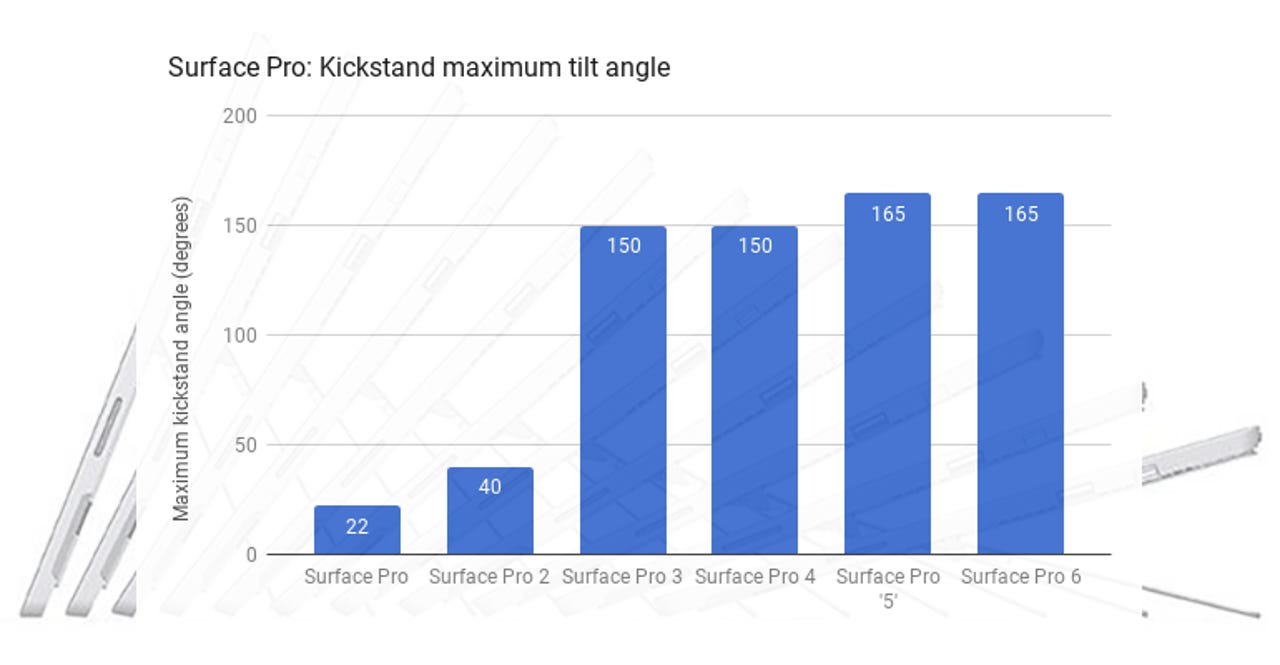Surface Pro: The evolution of Microsoft's hybrid tablet PC

Surface Pro 1-4
Microsoft's Surface Pro range of Windows tablet/laptop hybrids officially launched in February 2013, following a trailer at the Windows 8 and Surface RT event the previous October.
The first Surface Pro, originally called 'Surface with Windows 8 Pro', was a premium Core i5-based device costing $899 with 64GB of storage or $999 with 128GB, and you had to pay another $119.99 or $129.99 for a Touch Cover or Type Cover keyboard. This set the tone for the marque: high-quality, high-cost hardware, designed to showcase a new form factor and encourage OEMs to take the idea and run with it.
The following slides examine how the Surface Pro has developed over the years.
Surface Pro 6 (2018)
The (just) current Surface Pro model is the Surface Pro 6, which was a minimal upgrade to the 2017 version, adding quad-core 8th-generation Intel Core (i5 and i7) processors and a new black colour option. The Surface Pro 6 starts at $699 (8GB RAM, 128GB SSD, Intel Core i5), rising to $1,999 for the top-end configuration (16GB/128GB/Core i7). A Signature Type Cover will cost you another $159.99 and a Surface Pen $99.99.
CNET's verdict: "The latest Surface Pro tablet doesn't make any radical design changes, but the performance jump makes it viable as a mainstream performance laptop replacement."
Surface revenue
Since its launch in 2012, Microsoft has built the Surface brand into a successful business. Note that 'Surface' revenue in the above graph includes proceeds from Surface, Surface Pro, Surface Go and Surface Book (hybrid), Surface Laptop (notebook), Surface Studio (AIO desktop), and Surface Hub (presentation/collaboration screen) devices.
Microsoft's upcoming October 2 event could see several new Surface devices, including a USB-C-equipped Surface Pro, an AMD-based Surface Laptop and an Arm-based (Qualcomm 8cx) device. New services based around the Surface portfolio may also be unveiled.
Read more Surface reviews
- Microsoft Surface 3 review: The Pro 3's Atom-hearted brother
- Microsoft Surface Book review: High-quality premium-priced 2-in-1 hybrid
- Surface Book 2 (15-inch): Microsoft supersizes its most powerful portable PC
- Surface Laptop: A trip on the Windows 10 S express you'll end quickly
- Microsoft Surface Go: First impressions
- Microsoft Surface Studio, First Take: An appealing all-in-one debut, but the price is high
- Microsoft Surface Studio 2 review: A powerful digital drawing board
- Microsoft Surface Hub: Hands-on with the giant, expensive collaboration screen
Vital statistics
Over the years, the Surface Pro has expanded screen real estate and resolution, while getting lighter and slimmer. Compared to its first-generation 10.8-inch predecessor, the 12.3-inch Surface Pro 6 delivers 28.4 percent more pixel density, 126g less weight and shaves 5mm off the thickness.
The original Surface Pro came with Windows 8 Pro, while subsequent models have run Windows 8.1 Pro (Surface Pro 2 and 3) and Windows 10 Pro (Surface Pro 4, '5' and 6). Externally, the 2018 Surface Pro 6 barely differs from the 2017 model.
Intel processor generations
The original Surface Pro ran on a third-generation (Ivy Bridge) Core i5 processor with a TDP (Thermal Design Power) of 17W and required two (fairly noisy) fans to keep cool.
Since the Surface Pro 2, the maximum TDP has been 15W. The single-fan Surface Pro 3 suffered from overheating and fan noise issues, leading Microsoft to implement a hybrid liquid/fan cooling solution in the Surface Pro 4. The 2017 Surface Pro '5' with 7th-generation (Kaby Lake) Core m3 and Core i5 CPUs was entirely liquid cooled, although the Core i7 configuration required additional fan cooling, as does the Core i7-based Surface Pro 6.
Graphics performance
Performance has, of course, improved over the Surface Pro generations. Shown here are 3DMark Ice Storm Unlimited scores for the Core i5 versions of each generation. The CPU/GPU combinations are: Core i5-3317U/ HD Graphics 4000 (Surface Pro); Core i5-4200U/HD Graphics 4400 (Surface Pro 2); Core i5-4300U/HD Graphics 4400 (Surface Pro 3); Core i5-6300U/HD Graphics 520 (Surface Pro 4); Core i5-7300U/HD Graphics 620 (Surface Pro '5'); Core i5-8250U/HD Graphics 620 (Surface Pro 6).
RAM
RAM options have increased from one-size-fits-all 4GB of DDR3 memory in the original Surface Pro to 8GB or 16GB of LPDDR3 in the Surface Pro 6. Microsoft does not design the Surface Pro for upgradability: you've always had to specify the amount of RAM you'll need at purchase time.
Storage
Beginning with just 64GB or 128GB (and later, 256GB) of internal SSD storage in the Surface Pro, maximum capacity has grown to 1TB in the most recent models. The Surface Pro 4, '5' and 6 drop the 64GB entry-level option, and also use PCIe NVME SSDs rather than mSATA.
Battery
The original Surface Pro was widely criticised for its poor battery life, but Microsoft and its component suppliers have steadily improved performance in this critical area.
The battery life figures for the Surface Pro 3, 4, '5' and 6 are Microsoft's estimates for video playback time with wi-fi on and auto-brightness disabled (on a Core i5/8GB RAM/256GB SSD device); the figures for the Surface Pro and Surface Pro 2 are averages from multiple reviews.
Unless you run demanding workloads with screen brightness turned right up, the latest Surface Pro models should give you all-day (that is, over eight hours) battery life.
Repairability
Ease of access to the chassis and upgradable components are not a feature of the Surface Pro range, to say the least. The highest repairability score from iFixit is 2/10, for the Surface Pro 4 (you can, if you're brave, replace the SSD). All other models get a paltry 1/10.
Read iFixit's Surface Pro teardowns
Surface Pen
A key adjunct to the Surface Pro is the Surface Pen, which has evolved from a Wacom-made 256-pressure-level stylus in the Surface Pro to a sophisticated N-Trig pen with 4,096 pressure levels, 21ms latency, 9g activation force, tilt support, and three different tips, all of which makes for natural-feeling inking and shading.
Since the Surface Pro 3, the Pen has included a Bluetooth option where a button click opens OneNote on the tablet. With the Surface Pro 4, the ability to take a screenshot and open Cortana was added to this now-customisable 'magic button'.
The Surface Pen was bundled with the tablet until the Surface Pro '5', but is now sold separately for £99.99 in the UK or $99.99 in the US.
Making pen cool again: How N-trig won over Microsoft for the Surface Pro 3
Pen and tablet fail: Surface Pro 4 frustration forces return to older Pro 3 model

Kickstand evolution
Hybrid tablet/laptops with a kickstand design are commonplace nowadays, which is a testament to the influence of the Surface Pro range.
However, the first iteration was a limited affair, supporting just one, pretty upright (22-degree), angle. Since then, Microsoft's kickstand has developed into a versatile piece of engineering, and now supports multiple positions up to 165 degrees in the Surface Pro '5' and 6. Many users still find the 'lappability' of kickstand designs problematical, however.
Six months with the Surface Pro 4: Patches, lappability, and battery life are key
Enter the clones
Although the Surface Pro has turned out to be good business for Microsoft, a major reason for its introduction was to encourage the company's hardware partners to take the form factor and run with it -- which they have done. A 2017 ZDNet roundup featured examples from Chuwi, Dell, Asus, Samsung, Huawei, Lenovo, and HP, and also noted that "It's hard not to look at the iPad Pro and think it was introduced at least partly because of competitive pressure from the Surface family of devices".